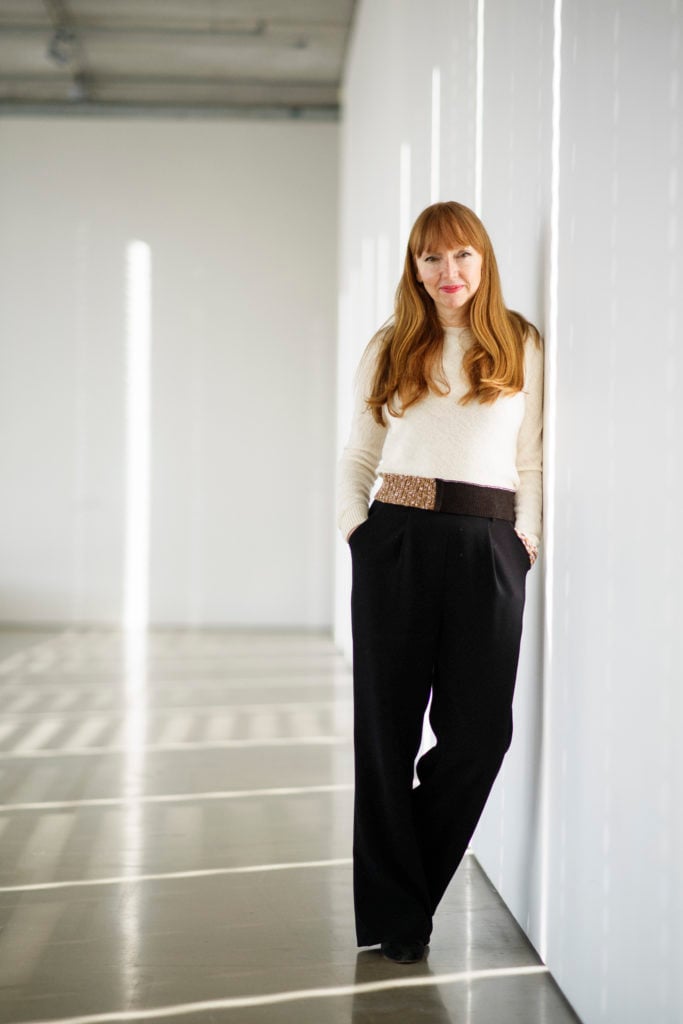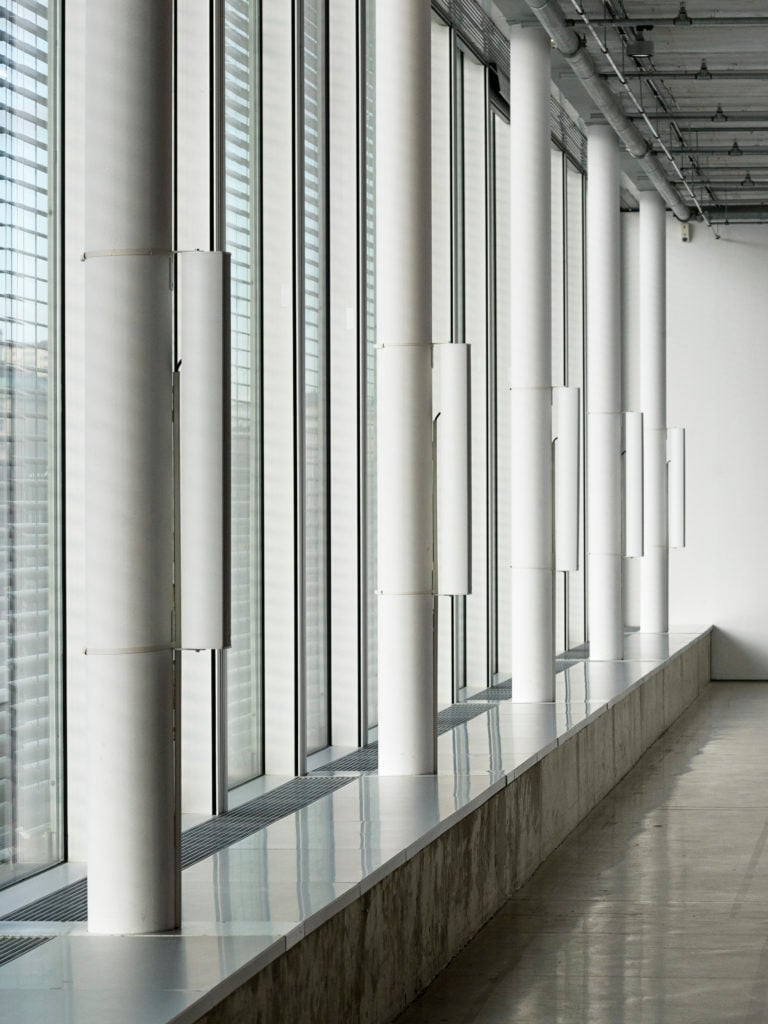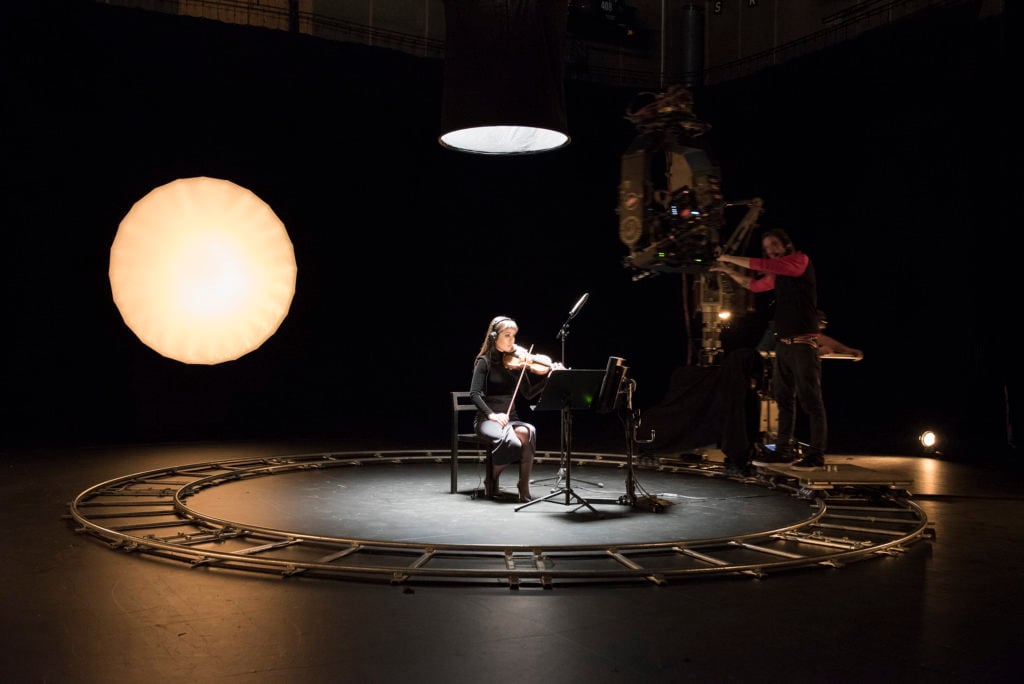Reviews
Susan Philipsz Shows Stellar New Work at Bonniers Konsthall
The sound artist's latest work deconstructs the music of an existential space opera.

The sound artist's latest work deconstructs the music of an existential space opera.

Alyssa Buffenstein

Each year, the Bonniers Konsthall in Stockholm welcomes an artist of the year, commissioning a new work for the institution and working together to develop an exhibition. This year’s invited artist is the Scotland-born, Berlin-based Susan Philipsz, whose main medium is sound. For her show, she looks to the stars—literally—for an exhibition called “Lost in Space.”
For her new commission, Philipsz began with the best-known work of Swedish writer and Nobel Laureate Harry Martinson (1904-1975). He published the epic poem Aniara in 1956, a futuristic tragedy about an eponymous spaceship carrying 8,000 people to Mars and Venus, after Earth has been made uninhabitable from nuclear war and human-inflicted environmental damage. The ship goes off course, earth is destroyed, and the passengers realize they are doomed to float through space until their deaths.
“In a way it’s quite resonant with what’s happening now with climate change and things like that. They’re trying to leave a poisoned planet. It resonates,” Philipsz tells artnet News at the Konsthall, in the days leading up to the show’s opening.
Aniara was turned into an opera by modernist composer Karl-Birger Blomdahl, who incorporated electronic music into the score, which he wrote using the 12-tone technique developed by Arnold Schoenberg. It premiered in 1959.
Philipsz was taken by the opera’s opening musical sequence, a violin playing the Morse code for “Aniara SOS Aniara” in a C note.
“That’s the opening of the entire opera, then it builds up and it’s so full, so eclectic, so many different styles. He introduced the first electronic music into opera. But it was this opening sequence that I found really compelling,” she says.

Susan Philipsz, “Lost in Space” installation view. Photo by Petter Cohen, courtesy Bonniers Konsthall.
Isolating the violin from the rest of the score, she then deconstructed the violin’s music into its 12 separate tones. Each is assigned its own speaker situated around the perimeter of the Konsthall, winding into the center of the space, where a darkened white box acts as a screening room for a film, the first she has ever made.
“I’ve worked with this process before, where I’ve sort of deconstructed compositions, taken them apart and reassembled them again, like with other 12-tone composers like Hanns Eisler. But this is the first time I’ve ever dramatized the process,” she says of the inclusion of a video in the installation.
“I had really wanted to make a film, so I am excited that I got to do that here in Sweden, with a proper crew, and a great cinematographer and a producer.”
In the film, titled A Single Voice, Leila Akhmetova, a young professional violinist, sits in the center of a sparse, dark, space-like set, wearing headphones and high heels, her violin tucked under her chin. She is listening to the opera, and following along from a book of sheet music, waiting for each C note. When the violin plays any of the 11 other notes, the viewer can hear them from their corresponding speaker in a different part of the room, but Akhmetova is only seen playing the C notes.
“It’s almost like, at times she is having a conversation with the other tones. And those tones are constantly shifting around the space, so then you become aware of the space, and the spatial aspects of the sound. They’re kind of orbiting around her, there’s a sort of call-and-response,” Philipsz explains.

Behind the scenes of shooting A Single Voice. Photo by Franziska Sinn, courtesy Bonniers Konsthall.
The Konsthall building, a rounded wedge lined in floor-to-ceiling windows designed by Stockholm-based architect Johan Celsing, is flanked by a pedestrian sidewalk and two-lane road of traffic on one side, and train tracks and a canal to the other. Standing inside the building feels a bit like what riding inside a spaceship might feel like. The viewer is isolated from the city outside.
“When I first came to see the space, I was struck by the movement on either side. So when you hear the sound moving from speaker to speaker, it sort of encourages, works with the movement of the trains somehow,” Philipsz says.
Deconstructing readymade musical scores is, in fact, one of her signatures. A 2001 work, Ziggy Stardust, is also on view here: a recording of the artist (who does not sing professionally, but was a member of her church choir) singing the entirety of the David Bowie album A capella, keeping time true to the original. Installed in a dark room lined with soundproof foam, the viewer is left alone inside periodic voids where the instrumentals should be.
“When you think about that album, it’s kind of like a song cycle about stars, and it deals with all these existential themes of alienation and separation and otherness,” she explains.

Susan Philipsz, Radio Star (2017). Photo by Petter Cohen, courtesy Bonniers Konsthall.
Another new work, Radio Star (2017), occupies a second small side room. It is the sound of the cosmos, or rather, one specific neutron star, PSR B0809+74, a pulsar nearly 1,000 light years away from earth. Philipsz worked with the Onsala Space Observatory in Gothenburg to record the electromagnetic radiation of the rotating star using a radio telescope. The captured white noise is displayed on a TV monitor, while a track of the radiation converted into sound is heard simultaneously, a consistent beat not unlike a heartbeat, or an army march.
“I decided to put it on a monitor so you could see white noise. When I first became interested in pulsars, it was because I had heard that you could tune in to the universe expanding, that the white noise in your TV is actually picking up signals from the time of the Big Bang. That blew my mind.”
The subtlest work included in the show is a wall drawing inspired by one that Philipsz created as a child, inspired by the British TV series Timeslip. And while her work is a more refined, even somber, meditation on themes of isolation, distance, and displacement, sci-fi entertainment has made an impression on Philipsz’s practice.
“Those programs like Star Trek and Timeslip, I suppose they kind of did inspire me, even today.”
Susan Phiipsz, “Lost in Space“ is on view at the Bonniers Konsthall in Stockholm from February 22 – May 6, 2017.